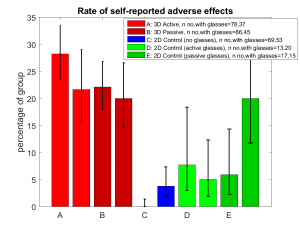I was giving a talk recently about my work on viewer experience with stereoscopic 3D television, and an audience member asked a good question, which was: Was there any relationship between people complaining of adverse effects and whether they routinely wore prescription spectacles? Such people are wearing two pairs of glasses to view S3D, which might be more uncomfortable, but equally they are already used to wearing glasses so might be less bothered than your average person who is wearing glasses only to view 3D.
We didn’t put anything about that in the papers, but I dug out the data and had a look. I haven’t done the stats, but it seems pretty clear there’s no effect of glasses. First, here is Fig 7 from Read & Bohr 2014:
And here is a version split up by whether or not participants usually wore glasses (in each pair of bars, the left-hand bar is for people who wore contacts or no correction, and the right-hand bar is for people who wore glasses).

In the graph, it looks as if there’s a striking difference in the “fake 3D passive” case, but really that’s to do with the small number of participants – we have 1/17 people without glasses reporting adverse effects, compared to 3/15 in the people with glasses. So if just one person changed their answer, it would look much less impressive. Since the effect isn’t seen in the other groups, I think it’s probably just a blip.
Averaging over all participants who wore 3D glasses (ie excluding only those in the true 2D group), the numbers are as follows:
n total = 311
n reporting adverse effects = 64 (21%)
n who habitually wear glasses = 117 (38%)
of whom n reporting adverse effects = 21 (18%)
n who do not habitually wear glasses = 194 (62%)
of whom n reporting adverse effects = 43 (22%)
Read JCA, Bohr I ( 2014 )
User experience while viewing stereoscopic 3D television
Ergonomics Vol: 57(8) Pages: 1140-53 [view on journal website] Pubmed ID : 24874550
Journal press release "Good news for couch potatoes".
2430 Downloads





















